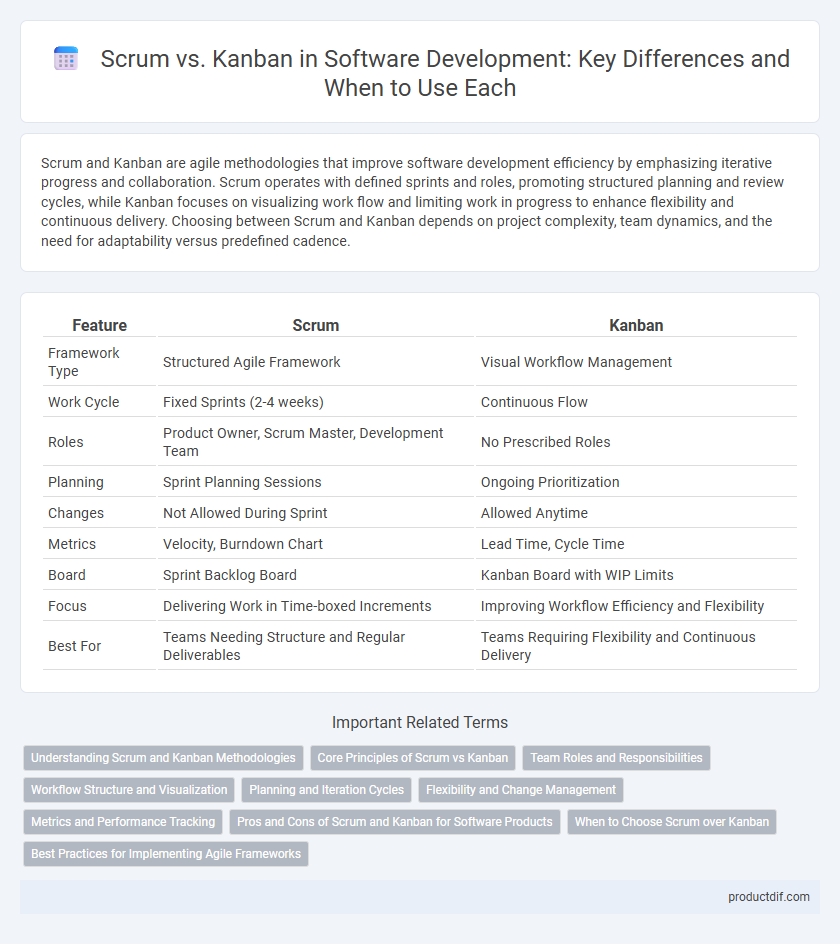Scrum and Kanban are agile methodologies that improve software development efficiency by emphasizing iterative progress and collaboration. Scrum operates with defined sprints and roles, promoting structured planning and review cycles, while Kanban focuses on visualizing work flow and limiting work in progress to enhance flexibility and continuous delivery. Choosing between Scrum and Kanban depends on project complexity, team dynamics, and the need for adaptability versus predefined cadence.
Table of Comparison
| Feature | Scrum | Kanban |
|---|---|---|
| Framework Type | Structured Agile Framework | Visual Workflow Management |
| Work Cycle | Fixed Sprints (2-4 weeks) | Continuous Flow |
| Roles | Product Owner, Scrum Master, Development Team | No Prescribed Roles |
| Planning | Sprint Planning Sessions | Ongoing Prioritization |
| Changes | Not Allowed During Sprint | Allowed Anytime |
| Metrics | Velocity, Burndown Chart | Lead Time, Cycle Time |
| Board | Sprint Backlog Board | Kanban Board with WIP Limits |
| Focus | Delivering Work in Time-boxed Increments | Improving Workflow Efficiency and Flexibility |
| Best For | Teams Needing Structure and Regular Deliverables | Teams Requiring Flexibility and Continuous Delivery |
Understanding Scrum and Kanban Methodologies
Scrum and Kanban are Agile methodologies designed to improve software development efficiency and flexibility. Scrum uses fixed-length sprints and defined roles like Product Owner and Scrum Master to promote structured collaboration and iterative delivery. Kanban emphasizes continuous workflow visualization through boards and limits work in progress (WIP) to optimize task management and reduce bottlenecks.
Core Principles of Scrum vs Kanban
Scrum is built on iterative development, emphasizing fixed-length sprints, time-boxed events, and defined roles like Product Owner and Scrum Master to foster collaboration and accountability. Kanban focuses on continuous delivery by visualizing work with a Kanban board, limiting work in progress (WIP), and optimizing flow without prescribed roles or time constraints. Both frameworks prioritize transparency and continuous improvement but differ in structure and process management, with Scrum enforcing time-boxed cycles and Kanban promoting a flexible, pull-based workflow.
Team Roles and Responsibilities
Scrum defines specific team roles including the Product Owner, Scrum Master, and Development Team, each with clear responsibilities to manage backlog, facilitate processes, and deliver increments. Kanban lacks predefined roles, emphasizing continuous workflow management where team members collectively own tasks and optimize processes through visual boards. The structured role assignments in Scrum enhance accountability, while Kanban's flexible roles foster adaptability and collaboration.
Workflow Structure and Visualization
Scrum employs time-boxed sprints with predefined roles and ceremonies to structure workflows, emphasizing iterative development cycles and regular planning. Kanban utilizes a continuous flow model with a visual board displaying work stages, enabling real-time tracking and flexible prioritization of tasks. Visualization in Scrum centers on sprint backlogs and burndown charts, while Kanban relies on cumulative flow diagrams and WIP (work-in-progress) limits to manage workflow efficiency.
Planning and Iteration Cycles
Scrum utilizes fixed-length sprints, typically two to four weeks, to facilitate structured planning and iterative delivery, promoting regular review and adaptation. Kanban operates with a continuous flow model without fixed iterations, enabling flexible work item prioritization and ongoing adjustment based on team capacity. The choice between Scrum's timeboxed sprints and Kanban's flow-based approach significantly impacts project planning, iteration predictability, and responsiveness to change.
Flexibility and Change Management
Scrum uses fixed-length sprints, which provide structured intervals but limit flexibility during development cycles. Kanban emphasizes continuous flow and adaptability, allowing teams to respond instantly to change without disrupting the overall workflow. This makes Kanban more suitable for projects requiring ongoing reprioritization and rapid response to evolving requirements.
Metrics and Performance Tracking
Scrum uses fixed-length sprints with velocity and burndown charts to track team performance and predict project timelines, emphasizing sprint goals and story point completion. Kanban measures flow efficiency, cycle time, and cumulative flow diagrams to monitor work in progress and identify bottlenecks, supporting continuous delivery without fixed iterations. Both methodologies leverage real-time metrics to optimize workflow, but Scrum prioritizes sprint-based progress, while Kanban focuses on throughput and process improvement.
Pros and Cons of Scrum and Kanban for Software Products
Scrum offers structured sprints and well-defined roles, providing clear deadlines and accountability but may be rigid for dynamic project scopes. Kanban allows continuous workflow and flexibility, enhancing adaptability and visual task tracking, yet it can lead to less predictable delivery timelines. Selecting Scrum benefits teams needing fixed schedules and iterative progress, while Kanban suits projects requiring ongoing changes and flow-based task management.
When to Choose Scrum over Kanban
Choose Scrum over Kanban when your project requires defined roles, fixed-length sprints, and a structured framework to manage complex workflows and deliverables. Scrum is ideal for teams needing regular planning, sprint reviews, and retrospectives to continuously improve processes and adapt to evolving requirements. Kanban suits projects demanding continuous delivery and flexible prioritization, but Scrum excels when iterative progress with clear timeboxed goals is essential.
Best Practices for Implementing Agile Frameworks
Effective implementation of Agile frameworks like Scrum and Kanban requires clear role definitions, consistent communication, and adaptive planning. Scrum emphasizes time-boxed sprints, daily stand-ups, and sprint reviews to foster iterative progress, while Kanban focuses on visualizing workflow, limiting work in progress, and continuous delivery to enhance efficiency. Integrating tools such as task boards and performance metrics supports team collaboration and drives continuous improvement in software development projects.
Scrum vs Kanban Infographic

 productdif.com
productdif.com